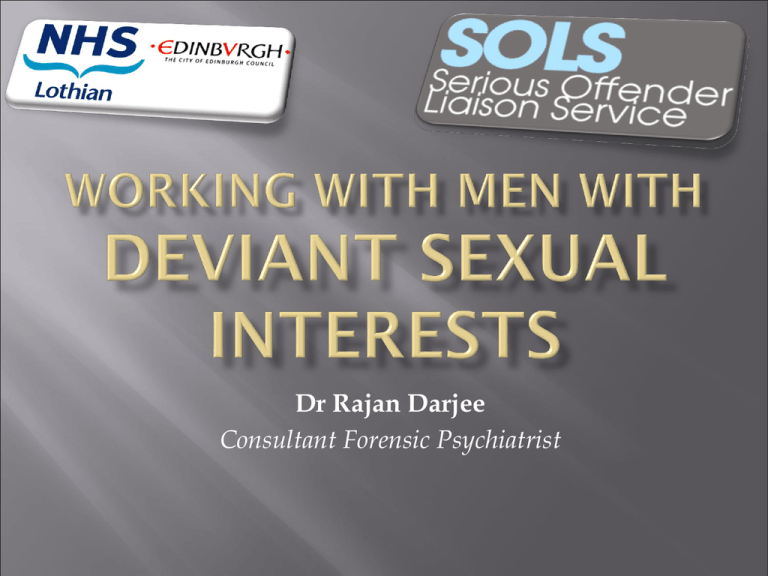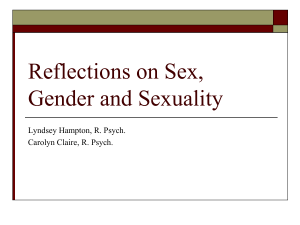
Dr Rajan Darjee
Consultant Forensic Psychiatrist
Biological
SEXUAL
INTERESTS
AND
BEHAVIOUR
Social
Psychological
Biological
SEXUAL
DEVIANCE
AND
OFFENDING
Social
Psychological
Sexual strategy theory
Sexual scripting theory
Cultural, interpersonal, intrapsychic
The big picture
Evolutionary psychology
Neurobiological, developmental, psychological,
social, cultural, population factors
Dual control model
Balance between excitatory and inhibitory
neurobiological systems
Whether sexual response and arousal occurs in a
particular individual, in a particular situation, is
ultimately determined by the balance of two systems
in an individual’s brain, the sexual activation or
excitation system and the sexual inhibition system,
each of which has a neurobiological substrate
Three basic assumptions:
1.
2.
3.
The effects of any stimulation depends ultimately on
neurobiological characteristics.
Neurobiological inhibition of sexual response is an
adaptive pattern, preventing distracting effects of
sexual arousal and appetite when sexual activity
would be disadvantageous or dangerous.
Individuals vary in their propensity for both sexual
excitation and sexual inhibition.
Sexual development
Sexual differentiation (anatomical)
Gender identity
Sexual interests, arousal, preference
Sexual relationships
Sexual identity
1.
2.
3.
Problems of reduced interest or response
Problems with gender or sexual identity
Problematic sexual behaviour
Sexual attraction
Sexual desire
Sexual interest
Sexual arousal
Sexual behaviour
Sexual fantasy
Sexual preference
Sexual urge
Is use of sexual fantasy different between offenders and
non-offenders?
Role of sexual fantasy:
Enhancement of positive mood state
Coping with negative mood state
Enhance sexual arousal
Escape from reality
Rehearsing sexual behaviour
Fantasy shapes and is shaped by behaviour and
experience
Range of arousing fantasies / stimuli
Sexual
desire
Nonsexual
behaviour
Refractory
period
Sexual
arousal
Orgasm
Brain structure
and function
Peripheral
organs involved
in physical
arousal
Spinal cord
Sexual
desire
Sensory organs
Non-sexual
behaviour
Sexual
arousal
Refractory
period
Peripheral
nervous system
Orgasm
Genital structure
and function
Autonomic
nervous system
Endocrine
system
Wider
range of
‘sexual
interests’
BEING
SEXUALLY
AROUSAL
Poor
attention /
judgment
Deviant
‘sexual
interests’
Development: childhood, adolescence,
adulthood
Range of sexual interests
No interest vs. some interest vs. strong interest
vs. preference
State vs. trait
Dimensional vs. categorical
In males there appears to be a critical period of
sexual development around puberty, when
sexual arousal to certain stimuli becomes an
established pattern
This is determined neurobiologically
But maintenance depends on subsequent
psycho-sexual experience/development,
abnormal learning
Prenatal androgen exposure
Fraternal birth order: mother producing antibodies to malespecific antigens in male foetuses
Non-right handedness
Structural findings:
Interstitial nucleus of the hypothalamus and suprachiasmatic nucleus
Hemispheric volume symmetry
Anterior commisure
Functional findings
Effects of pheromones
Functional cerebral asymmetry
Response to visual sexual stimuli
Neuro-imaging
Neuropsychology
Klinefelter’s syndrome
Endocrine
Executive function
Intelligence, memory, handedness
Emotional intelligence
Brain injury and sexually inappropriate behaviour
Genetics
Temporal lobe abnormalities
? Frontal
? Amygdala / other subcortical areas
Functional imaging studies emerging
Testosterone
Neurotransmitters
5-HT
Becerra-García, JA (2011) Magnetic Resonance Techniques in Study of Sexual Stimuli
Processing in Paedophilia. In Neuroimaging for Clinicians (Ed. Peres JFP) InTech
Becerra-García, JA (2011) Magnetic Resonance Techniques in Study of Sexual Stimuli
Processing in Paedophilia. In Neuroimaging for Clinicians (Ed. Peres JFP) InTech
Role of other factors in development and
maintenance of deviant interests
Role of other factors in precipitating
experiencing deviant interests
Role of other factors in precipitating acting on
deviant interests
Paraphilias
Deviant
sexual
behaviour
Sexual
offending
CRITERION A
Recurrent, intense sexually arousing fantasies, sexual urges or
behaviors
Generally involving
Nonhuman objects, or
Suffering/humiliation of oneself or one’s partner, or
Children or other nonconsenting persons
Occurring over a period of 6 months
CRITERION B
Cause clinically significant distress or impairment in social,
occupational, or other important areas of functioning
A. Over a period of at least 6 months, recurrent
and intense sexual arousal from_________ as
manifested by fantasies, urges or behaviors.
B. The person has clinically significant distress
or impairment in important areas of
functioning or has sought sexual stimulation
from ___ or more unsuspecting strangers on
separate occasions.
C. Exclusionary criteria (when applicable)
Specifiers – Eg. course and remission – Eg. nonexclusive behavioral manifestations
DSM IV TR
Exhibitionism
Fetishism
Frotteurism
Pedophilia
Sexual masochism
Sexual sadism
Transvestic fetishism
Voyeurism
Paraphilia not
otherwise specified (e.g.
necrophilia, zoophilia)
DSM 5
Changes:
Pedohebephilic disorder
Paraphilic coercive
disorder
Hypersexual disorder
(nonparaphilic but
associated disorder)
Paraphilias
Sexual preoccupation
Hypersexuality
Sex offenders in the
community
(Hanson and Harris)
‘Paedophilic sex offenders’
(Raymond et al. 1999)
Referrals for specialist
residential treatment
(Dunsieth et al. 2004)
Sexual murderers
(Stone 2001, Firestone et al .1998, Proulx
& Sauvetre 2007, Hills et al. 2007)
• 20%
• 53%
• 75%
• 18-80%
Important risk factor for sexual recidivism
(many studies and several meta-analyses)
Particularly sexual interest in children (PPG,
SSPI)
?Interest in sexual violence
?Sexual sadism
?Other paraphilias
Overtly present in:
SA07
SARN
RSVP
SVR-20
SORAG
By proxy in:
RM 2000
Static 99
RISK FACTORS
Historic/static
Stable dynamic/dispositional
Acute/precipitating
PROTECTIVE
Internal
External
History from the individual
Reports from other people
Observation of behaviour
Use of sexually stimulating materials/media
Self-report questionnaires
‘Objective’ measures
Penile plethysmography (PPG)
Viewing time measures
Choice reaction time
Implicit association tests
Rapid serial presentation test
Stroop tests
Startle probe refelex
Objective behavioural scales
Sexual Sadism Scale (SESAS; Nitschket et al.
2012)
Screenig Scale for Pedophilic Interests (Seeto
1.
2.
3.
4.
5.
Sexually aroused
during offence
Exercises
power/control/domi
nation
Torture/cruelty
Humiliating/degradi
ng
Sexual mutilation
6. Non-sexual mutilation
7. Gratuitous violence
8. Inserts objects
9. Ritualistic acts
10. Abducts or confines
11. Keeps trophies
PART 2
1.
Pre-plans offence
2.
Cruelty/torture of
other persons or
animals
3.
Evidence of sexual
arousal by sadistic
acts/fantasies
SUMMARY EVALUATION
Empirical assessment
Part 1 score 4-11 = probably
sexual sadism
Summary assessment
Part 1 & 2 and any other
material:
Sexual sadist Y or N
1.
2.
3.
4.
Boy victim (2)
Unrelated child victim (1)
More than one child victim (1)
Victim under 11 years old (1)
Only count victims if aged 13 or younger
Score of 4 or 5 indicates likely
Evidence that voluntary and mandatory postconviction polygraph testing facilitate
disclosure of sexual interests and treatment
Mandatory testing has been introduced and
evaluated in England and Wales
Recent case studies from Broadmoor Hospital
Static factors
Stable dynamic
factors
Acute dynamic
factors
Triggers
OFFENCE
Predisposing
Precipitating /
offence analysis
Formulation
Perpetuating
Protective
Predisposing
Precipitating / offence
analysis
•Stable dynamic factors
•Personality
•Role of mental disorders
•Motivation
•Destabilisers/disinhibitors/triggers
•Victim selection
•Method of offending
Formulation
Perpetuating
Protective
• Ongoing stable dynamic factors
• Response to interventions
• Response to offences
• Reasons for chronic or escalating
offending
• Intrinsic strengths
• Extrinsic supports/controls
• Consider desistance and ‘good lives’
• Consider periods of non-offending
Many child sexual offenders do not have a
persistent sexual preference for children
Internet offenders> extra-familial contact
offenders > intra-familial offenders
Most men who offend against older teenage
girls are no paedophilic
Some paedophiles are only aroused by prepubescent children, but most are not
Up to 10-20% of males show some sexual
interest in children
Problems with definition and assessment
‘Sadomasochism’ vs. ‘criminal sexual sadism’
Very few rapists are sexually sadistic (<5%)
A significant number of sexual murderers
(about 30-40%) are sexually sadistic
Most repeat sexual murderers are sexually
sadistic (90%)
Sexual sadism + serious contact offending =
extreme caution required
In some countries long-acting anti-libidinals by
injection are seen as a necessary treatment
Men who use child pornography have high
rates of paedophilia (higher than other child
sex offenders)
Is this a group who despite deviant interests
are less likely to commit contact offences?
Extreme pornography – new legislation
regarding images/videos depicting bestiality,
sadism and/or necrophilia
Interviews and your reaction
Only problem if functionally related to
offending
Addressing other factors and facilitating health
sexual relationships and functioning will deal
with it in many/most cases
How to choose intervention approaches
Range and course of deviant interests
Motivation
Formulation
What does he want to achieve
Timing
1.
2.
3.
4.
5.
6.
7.
8.
9.
10.
Identify for whom you are working
Facilitate disclosure
Establish what the problem is
Why is the person seeking help now
Avoid one-sided treatment plans
Intervene quickly
Be persistent
Series of ‘experiments’
Be inclusive and collaborative
Be optimistic









